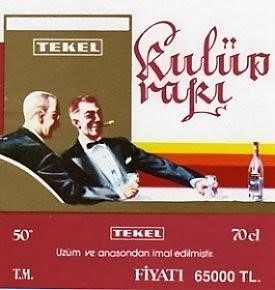
The Contributors

Smyrna On My Mind
“To our grandchildren and future great-grandchildren, with love.”
Preface
This modest work does not pretend to be an academic dissertation, nor is it an essay on the history of the ancient city of Smyrna which was named İzmir by the newly established Turkish Republic, in the early 20th Century. My work simply recounts my childhood memories and those of my father; each of us born into what could now be considered as two different worlds.
In the course of this tale, we inevitably stumble across some results from my tentative research far into our family history. It also emerges that in the face of strife and desolation; we prevail. We remain devoted to God, and His Holy Providence does provide. Our motto: Nil desperandum!
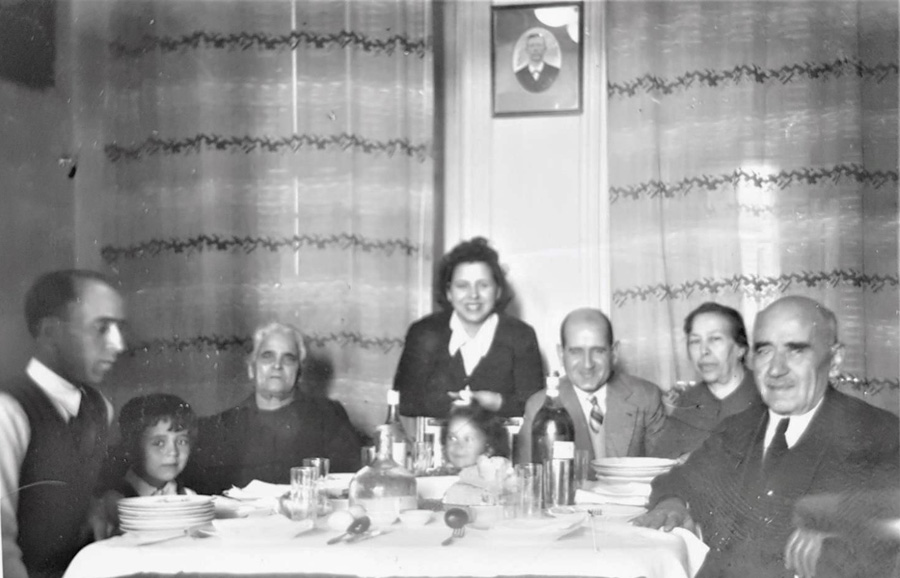
Sunday lunch in Smyrna (Izmir) c. 1949.left to right: My father Peter Polycarp Galdies, my brother Paul Winston, Grandma Eleni Galdies (née Gatopoulo-Bogavich), little me just visible under my mother Mary (née Aicolina), her brother Uncle Anthony Aicolina, step Grandma Alexandra Aicolina (née Fenech), and Grandpa ‘Georgie’ Aicolina. These were the protagonists of my early upbringing!
“My language of choice”
Instead of asking the question “what is your mother tongue”? in today’s multi-ethnic, multi-cultural world of communications I believe the question should be: “what language do you think in?”.
In my case, and because I’ve been domiciled continuously in Britain for over 50 years, I now find myself consistently thinking, and also dreaming, in English. But very often my thought process could be influenced from such factors as childhood memories, education, and received ideas which comprise sayings, proverbs, lyrics, and poems. And when such thoughts come to mind, they are each in their own vernacular.
This richness of form derives from ‘received language’ in the home, and this was typically: Smyrneika Greek which we Franco-Levantines called “Romeika” which in its written form was termed: “Fragochiotika” i.e. (Frankish of the Greek Island of Chios). In our ‘Smyrneika Lexicon’ book, we explain that “Romios” is a derivation of Roméos: a citizen of the Eastern Roman Empire, i.e., a Byzantine. These spoke “Romeika”, which in turn was subdivided into Smyneika: Smyrna Greek, and “Politika”: Constantinople Greek.
Consequently, Romeika was left being spoken only by certain remote communities of the Anatolian Black Sea coast who have chosen to maintain through the centuries this language and its peculiar grammar, and many of their social traditions, whilst submerged by the spectacular growth around them of modern Turkey.
Modern Greeks openly disliked the use of the above quoted terms. They referred to themselves as Hellenes, and to their language, as Elliniká (which means spoken-Greek).
In my own childhood as an ethnic Greco-Latin-Levantine, Smyrneika was generally spoken in the home (mainly in the kitchen), French in the lounge and at school, and English would appear in nursery rhymes and bedtime stories. Playtime in the yard or in the empty streets of the 1950s, yielded an additional good dose of Italian and American-English from friends and neighbours. Turkish was of course the national language.
Above all, learning Greek and Latin languages from the cradle endowed me with the knowledge of grammatical gender of animals, plants, and inanimate objects: a true richness!
It is worth adding here that by the time Smyrna truly became known as Izmir, say the end of the 1950s, there was still a sizeable Jewish Sephardic community that gave us occasional snippets of their Sephardic Spanish i.e., ‘Ladino’ terms and expressions. Whilst a teenager I also had the opportunity of meeting expatriate German youths who implanted into me some basic understanding of their language which proved quite useful in later life as a regular business visitor to that great country.
I feel that I also ought to add that Latin American music and songs were much appreciated in the 1960s’ Izmir, to the extent that we had regular musicians and cabaret troops from that continent. As regular patrons to the Saturday afternoon “thés dansants”, we; mostly the Levantine and Jewish teenagers, had ample opportunity to engage the transient artists on tour. Izmir routinely hosted international performers such as Sasha Distell, Charles Aznavour, Enrico Macias, Luis Alberto del Paraná, etc. Interacting with cabaret artists from time to time provided great opportunities to get to know about their countries and customs.
But foremost in my mind is knowing that when in Greece I am easily mistaken, at least at first, for a native “Hellene”, this thanks to having acquired from birth the “ghlosa”. This Greek word literally means ‘the tongue’ as in: ‘the language’. Learning it from birth bestows a person a natural ease of pronunciation which in my view conveys affinity and kinship.
Therefore, as far as I am concerned, all the above contributed to my growing up as a true Smyrnaean Levantine who’d inherited the attributes of the multi-cultural ‘city-state’ that I was born in. Happily; Izmir (Smyrna) has to a minor extend still kept those cherished attributes. And as for me: Smyrna is where I am!
- 0 -
I started my schooling with the French Daughters of Charity (order of St Vincent de Paul). This Vincentian religious sisters’ nursery was called “asile” in those days, and ‘jardin d’enfants’ or kindergarten, nowadays. This nursery was part of a Roman Catholic complex which included the “French Hospital”, a beautiful chapel, and an efficient elementary and secondary school for girls, all set around immaculate flower beds punctuated with statues of saints.
Replacing its pre-fire predecessor, the new 1930s chapel and the adjoining equally new convent, had a pure French “Style Paquebot” essence, reminiscent of works by architect Pierre Patout. Everything in the chapel, including the holy statues, was painted in a very delicate ivory grey, conducive to contemplation, and devotion.
From the French Sisters’ nursery school, my next step was onto the De La Salle Catholic Brothers who ran the only French ‘collège’ for boys that had survived the catastrophic fire of 1922.
Here I was educated in French, Turkish, and to a lesser extent, English. Our maths and English language teacher Brother Alfred, had studied English in Scotland, a fact that he was proud to share.
In parallel, I had also private tuition of Turkish and English.
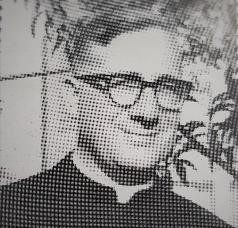
Additional Maths and rudiments of Reason were provided in Italian by our Italian parish priest, the popular Padre Giulio Sergio Battola, RIP (in Izmir 1960 to 2010) who exuded the youthful energy of his origin from the Italian Alps. In exchange for his time and patience I would guide him practicing English with Linguaphone records, and assist by helping with logistics for his foreign visitors such as students and professors from the Bible School of Jerusalem, located in East Jerusalem which at that time was under the Hashemite Kingdom of Jordan. Our excursions mainly involved visiting the ruins of Ephesus, Sardis, etc.
In the 1960s, I subscribed to correspondence courses in modern journalism with London schools. Whilst these courses opened my eyes to UK politics and world current affairs, I also studied to pass British GCE O and A level examinations in French and Turkish Languages, and a variety of other subjects.
Against all the apparent odds, my number one priority remained to enjoy the life I had been given. Throughout my life, God in his infinite love and wisdom has indeed blessed me with plenty of fun and excitement, and helped me achieve all my aims and aspirations. And He still does to this day.
- 0 -
Learning Turkish: the language and culture
Sometime in the 1950s my father acquired what I called his ‘toy farm’. This gave me the opportunity to practice common Turkish with the farmhands, whilst unconsciously copying their heavy accents. This interaction with them also revealed to me the many aspects of their Anatolian culture which was seriously safeguarded by what the Turks call “Örf ve Adetlerimiz” which I’d translate as ‘our values and customs’. On top of these came respect for elders, teachers, health workers, and for all those wearing a military uniform!
Further in my narration we shall discover how my father’s early childhood strongly influenced his own determination to become self-sufficient in fresh food, and explains his doggedness in keeping this ‘toy farm’ although this was a scarcely viable non-commercial enterprise.
I particularly remember a certain Murat who was hired to help in building a ‘koula’ i.e., a stone-built cottage. Koulas were built at an elevated position to afford a view over the entire, and in our case modest, property.
Murat was a Laz: the ethnic group of inhabitants of the eastern Black Sea coast and mountains of northern Anatolia. As I found out in later years, the Laz were and are very close in appearance to the Georgians, including some present-day Jews of my acquaintance who could trace their ancestry to Georgia too.
The book “Eastern Turkey” by Gwyn Williams published in 1972 tells us that there were about sixty thousand people in Turkey who claimed to be Laz. Today in 2021, I would expect that figure to be in scores of millions, since the Laz seem to have thrived in Western Anatolia especially in Istanbul and Ankara, and also Izmir, in various sectors of commerce and industry.
Williams suggests that they are probably the original inhabitants along the Black Sea coast in Antiquity, and would precede the coastal colonies of the Greeks. Interestingly these people were Christian until the fifteenth century when Mehmet the Conqueror captured Trebizondas, modern Trabzon, and had subsequently converted them to Islam.
It is my understanding that the Greek and Latin communities of the Turkish Black Sea coast continued to thrive until the end of the Ottoman Empire. But nowadays there is only one Catholic church still operating, and one beautiful Orthodox church preserved as a museum, whilst others have been turned into mosques, or other public buildings. In my opinion gratitude is owed to the Turkish government who since the 1990s have been preserving historic churches and synagogues in various towns and cities.
Murat was tall and of fair complexion and sported a rather formidable handlebar moustache. He had left his family behind in his native mountain village and was working hard to earn a living. He displayed his mountain-dwellers’ habits by his accomplished carpentry and carving skills, and he also preferred to grow vegetables; especially cabbage and other brassica as a commercial crop, rather than tobacco: the traditional crop of the Balkans, western Anatolian and Thracian people. He’d accepted to run the farm for us on a permanent basis. (The Aegean region was by now populated by Turks from Thrace: in the exchange of populations of the 1920s, and previous to that, housing the Turkish refugees fleeing the independence wars of the Balkan states).
Through observing Murat, it did not take me long to learn how to use an adze for shaping stakes, and even more importantly I learned how to shape and even plane a rebate into timber to make a window frame! Not surprisingly this exposure to hand tools stood me in good state, since some 30 years later, I was deeply immersed in the hand tools industry, developing international markets from Russia all the way down to South Africa as a commercial director of the world’s leading tools company.
Until the arrival of Murat, apart from tobacco growing, our land relied on the seasonal sale of fresh Smyrna figs and on the crop of its few olive trees. He persuaded my father to buy a cow off a neighbour (a Holstein, which my mother named Augustine) so we could have milk, also to make butter and yoghurt, and often “Mizithra”: best described as a salted or unsalted cheese product of whey, typical of the Aegean and dating into antiquity. It is delicious with honey on freshly baked bread! Needless to say, we never lacked in dairy products at that time. Mizithra is still popular in Crete.
Sadly, Murat returned to his homeland and was replaced by a central Anatolian family. I could not remember from which town, although their accent was quite deep and their view of the modern world rather limited. I do remember learning some of their idioms, and words like “gayri” meaning ‘no longer’ but also meaning ‘what’s done is done’, which would pepper Anatolian conversations in those days. Some people would say: “It is what it is” in colloquial English. the French would favour: “au jour d’aujourd’hui”.
During the annual Izmir International Fair period, we took ‘our farmers’ to visit the town, as they had never seen the sea, let alone an international event. They gaped at the modern apartment buildings that were rising all over Alsancak (the previously Greek quarter that had been burned down), and asked us if all these new buildings were for the ‘giavours’. When quizzed as to who these ‘infidels’ were, they said: “the Rums”, in their mind: the Greeks and Armenians. We felt we had to bring them up to date that these giavours had long disappeared and that all these apartments were built by, and for the Turks. That seemed to have put their minds to rest, but not ours. It reminded us of the Cyprus troubles flaring once again, and of the memory of the 1955 pogroms against the very few local Greek merchants of Izmir and Istanbul, that had taken place.
The farmer’s family consisted of the father, mother (whose name I believe was Gülbahar), and two young daughters. The only thing I remember of these girls is that they were proud to be endowed with six toes! A feature that did not prevent them being hardworking. Their father had ruled that growing cotton was his commercial crop of choice and saw to it that his women will tend the cotton field accordingly. On his insistence we purchased a short legged possibly just over 12 hands ‘Arabian-Cretan Messara’ pony. Or so I believe. Sadly, I cannot recall the horse’s name for certain, but I think I’d called him Gene Autrey, but as a single Turkish-pronounced word: Djinotry, as seen and heard in the firm Westerns and comics of my childhood.
The idea was that whilst cotton would be growing on the main, the father would concentrate on taking produce from the vegetable garden to market in the nearby village of Seydiköy.
As it turned out this arrangement went well the first couple of years, during which I had the opportunity of learning to ride the horse bareback, i.e., with no stirrups or saddle and just a rope for reins. That was fun and I cannot recall ever falling, nor can I remember ever going into a gallop either!
One year we had to come to England, and my father left the man plenty of money to feed his family and plenty of grain for the horse. But the joy of our return was soon to be short-lived when we found our lovely Djinotry in a miserable state. When challenged, the farmhand explained that there had been a drought and was obliged to sell the horse’s grain to sustain himself, as his vegetables were below par for the market.
The neighbour from the adjacent farm, Shakir Agha as I remember: a Turk from Crete who had arrived with the 1923 population exchange and spoke fluent Greek with a strong Cretan accent, recounted however the different story that our jolly farmer “used the horse and cart to go and enjoy himself in the nearby market town of Seydiköy!”
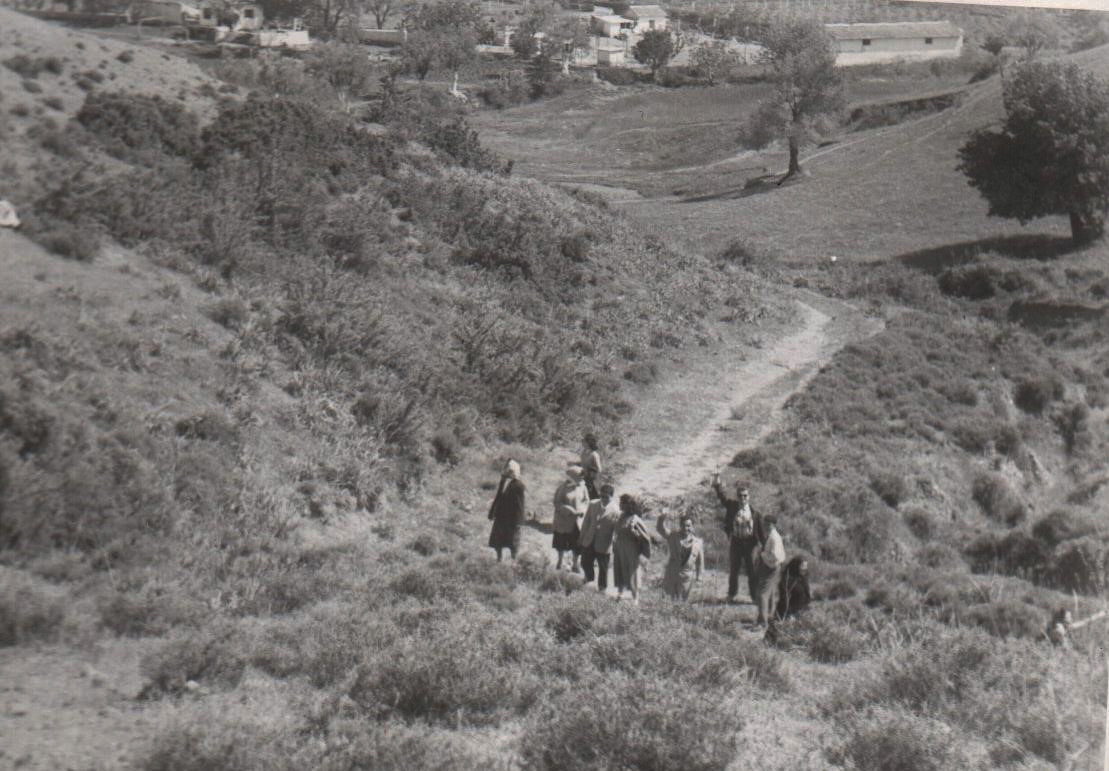
Picture shows a group of friends of my parents enjoying a walk in the heights above the “farm”.
The preceding paragraphs reveal the extent of my acquaintance to some Anatolian culture in my early years.
During this childhood in Izmir, there had been little opportunity of contact with immediate neighbours to properly practice Turkish (most of them being Greek-speaking Turkish Cretans of an advancing age), nor with Turkish school-friends as most of them lived far from our house.
These Turkish boys were generally kind-hearted and displayed a great sense of humour. However, since all communications within the school grounds were strictly ‘in French-only’ under risk of a fine, the opportunities for expanding my Turkish were limited. Consequently, my parents had to pay for extracurricular Turkish tuition for me so that I could pass exams in that language. These lessons were taking place during the summer holidays in my tutor Monsieur Polycarpe Çavuşoğlu’s bucolic back garden. He was a lay prep-school teacher at our school, teaching French to Turkish boys. During his private lessons at home, he was often assisted by his daughter Jeanette who was very patient in the face of my slow progress. They were a lovely Latin Catholic family, Turkish nationals, probably of indigenous Greek Ottoman descent. I believe their children and by now, grandchildren, are still thriving in Izmir.
Furthermore, my exposure to Turkish language and culture was enriched by our family trips to the interior; to places like Aydın, Denizli, Afyon, and further afield to Istanbul, Ankara, Antalya, and Adana, Mersin and Iskenderun to the east. Visits to Istanbul were particularly memorable as they involved my paternal grand-mother Eleni coming with us. For her, visiting the Agia Sophia Basilica was a true pilgrimage: a core manifestation of her faith. She used to call Anatolia and the Levant ’Agia Homata’ i.e., “The Holy Soils (Earth)”.
This expression had been adopted by the West as “The Holy Land”. I find Atatürk’s modern version ‘Kutsal Topraklar’ i.e., Sacred Earths more accurate since the archaic original Greek expression referred to the soil itself and not the land.
For myself, apart from the celebrated toy shops of the Grande Rue de Pera of Istanbul (today’s İstiklal Caddesi), what impressed me most were the sounds of Greek songs played aloud on gramophones, and the plethora of Greek and Levantine buildings, also the vast amount of Istanbul’s ‘Romeika’ Greek spoken with its heavily pronounced letter “λ” lambda.
Add to this French and Ladino Spanish being spoken in the streets, especially in the various restaurants of the Pera/Istiklal High Street. Sadly, though all this was brought to a sudden end with the pogroms of the 1955s linked to Cyprus demanding independence from Britain and union with mainland Greece.
Details of my favourite memories of my childhood’s İstanbul remain as the size of the enormously long bathtubs of the Pera Palas, and the delicious roasted quails which the Greek maître d’hôtel so obligingly produced for me every lunchtime as this was the only dish apart from shish kebabs, that I fancied eating. Though I caught up with the unique delights of Turkish cuisine later!
Discovering İstanbul at a very young age, especially the Pera Palas, the busy metropolis and hustle and bustle of some districts, the imperial palaces, the mosques and churches, especially the perceptible arrogance of its citizens, all these would have engendered in me a certain love-hate feeling that was to come back to me each time I visited the “πόλεις” i.e., “the city” in later years.
- 0 -
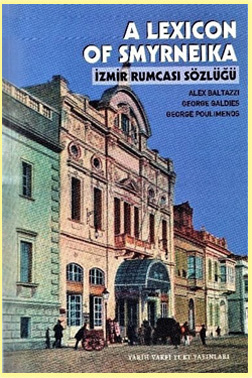
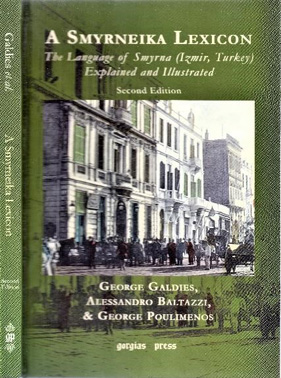
“A Smyneika Lexicon” revisited
In 2010; through email exchanges and numerous telephone calls with my two co-writers George Poulimenos in Athens and Alex Baltazzi, RIP in Izmir, we achieved the publication of a vocabulary of Smyrna/Izmir idiom which we entitled A Smyrneika Lexicon [ISBN978-1-4632-0251-4]. Whilst revisiting this lexicon recently, I had the idea to use the same alphabetical order for recounting here my childhood recollections of people, events, and places of Smyrna/Izmir that were to continue having an influence on my later life.
And in this process, I will also attempt to list events that have formed my own, and I believe also that of the “Levantine Community’s” psyche in the early 20th Century, which in my judgement, was a century that was (apart from the Dictators), negatively? influenced worldwide by thinkers who in large parts were deniers of science and biology whenever it suited. I count amongst these, and in no particular order: Saul Alinsky, Sartre, de Beauvoir, Marx, Antonio Gramsci, Alfred Kinsey, Dawkins, Freud, Mao, Keynes…
I am convinced that the 20th was the century that gave us (in no particular order) what we now call:
Nationalism, Fabian Socialism, Critical Theory, Humanism, Liberal Capitalism, Neo-Liberal Capitalism, “The Sexual Revolution”, The Culture of Death, Political Correctness, Moral Relativism and, with the “Cancel Culture”: The Death of Free Speech, and now “Wokism”.
The 20th century yielded in my opinion mindless and cruel worship of self which now, in the 21st we also see as the pornification and sexualisation of society especially of the young and innocent who, in the absence of a moral education, also have to endure to being merely instructed and indoctrinated, and as a result, find good education an alien concept… Nietzsche would have felt so much at home in this first quarter of the 21th Century where inversion of values seems to reign supreme! As 21st Century Pope Francis comments: “The world tells us to seek success, power and money; God tells us to seek humility, service and love”.
I believe I can safely tick as done all these last three exhortations, whilst also seeking forgiveness for outstanding past sins.
INTRODUCTION
Ranked in alphabetical order the following are some names, words, and events that have stuck in my mind and ‘saɪki’ or psyche, ever since that ‘Smyrnaean Childhood’ of mine. Several individuals, places, and events mentioned in my recollections each already have their own entries voiced by diverse contributors in the ‘Levantine Heritage Foundation’s website: Levantineheritage.com.
I shall therefore not dwell or elaborate on those, but rather concentrate on hitherto unreleased material which includes passages from my father’s own childhood reminiscences.
With my father’s and my own recollections combined, there emerges the story of two generations of survivors whose ancestry could be traced through centuries to a whole line of perceptibly ‘self-reliant survivors’. Our two childhoods were innately similar, yet materially different.
- 0 -
A
The letter A: Pronouncing it the Latin way as “a”, (as in apple): this was amongst the first things I learned as an infant. When in pre-school, the Sisters taught us the French alphabet. This has stood me in good stead, enabling me to speak French in pure and short vowels without the of impediment of English diphthongs for instance, nor for that matter insist on that heavy first syllable whether or not such weight of modulation is appropriate to the word.
Having had Greek-speaking grandmothers and aunties, I, like all my fellow Levantines, had the benefit of being spoken to in colloquial Greek. Consequently, the letter α Alpha also reminds me of learning the Greek alphabet. Although today I can only remember the capital letters!
- 0 -
“A” for Aicolina: my maternal grandfather George Aicolina who was of Maltese-British descent. As this 1900 consular registration foil below left shows, my grandfather George Aïcolina(Acquilina) was the seventh child of Lucas Acquilina (Aicolina): a Maltese stevedore who was born in Smyrna in 1852. All British Subjects were registered with the British Consulate so as to be located in case of strife necessitating eventual evacuation. Births, deaths, and marriages were registered separately.
By the age of 48, Lucas had fathered 10 children, the first six being girls. I expect this high number of children was common then, especially amongst low-income families. Also, having at very least one boy was crucial for most fathers those days. After the arrival of my Grandfather George, the next three were also all boys.
In chronological order these children were: Alma, Pasqualina, Carmena, Emilia, Maria, Paulina/Pavla, George, Francesco, Vincenzo, and Joseph.
Vincenzo had the reputation within the family of having rather bushy eyebrows.
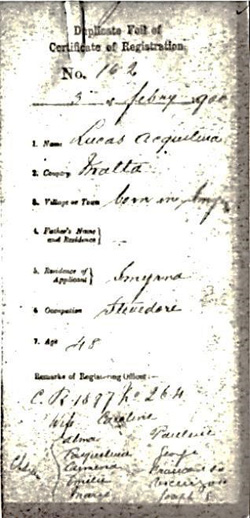
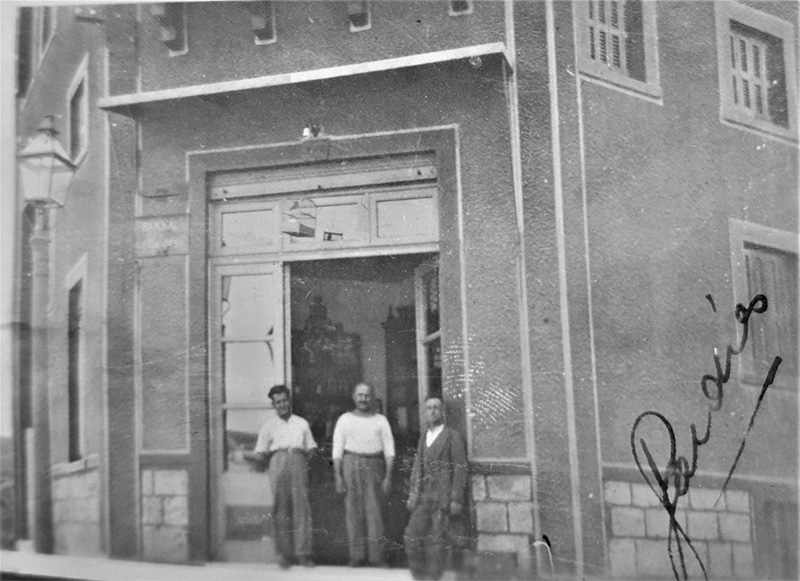
George Aicolina (centre) standing in front of his grocer’s shop. His son Anthony on his left, one of the Fennechs on his right.
Notice the gas street lamp to the left of photo and the nightingale cage hanging from the steel shutter!
Below is the Catholic Church registration entry of the Marriage between George Aïcolini my Maternal Grand-father: (son of Lucae Aicolini and Carolinae Née Ciglia), to Anastasia: daughter of Demetri Calopedis and Mariae Cacaros (both of Greek ‘religion’). The witnesses were John Baba and Thalia Manusso. The marriage took place on 12 November 1908. [this document courtesy of Marie Anne Marandet, GENEANET member]
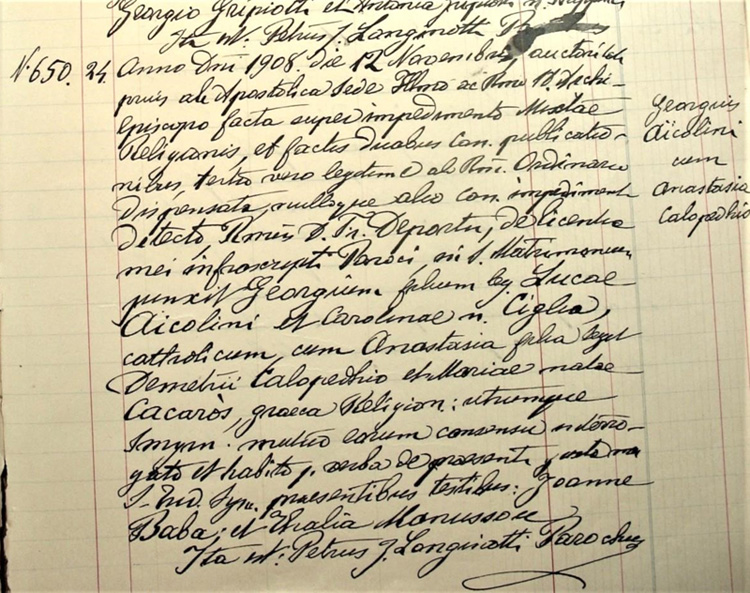
I used to have two theories as to the origin of the Aicolina/ Aicolini surname. Originally, I thought that in its present form it would be acknowledged as a misspelling of Aquilina, a derivation from aquila: the eagle.
My first option therefore, was that the “Aquilino” masculine version of the surname Aquilina might been found in the 11th century at Benevento, a city north of Naples. Riccardo Aquila was master of much territory in this area in 1090. In view of Malta’s rule under the Kingdom of Two Sicilys, it is possible that some of his descendants, legitimate or otherwise, may have adopted this surname as was common practice in those days to espouse or assume the family name of the head of a clan.
The second speculation as to this surname’s origin, would date from 1223. That is when Thomas, count of Celano, (a city of Abruzzi, Italy), was expelled by the Swabian rulers who had taken over the rule of Sicily. Thomas moved to Malta with all his dependents. The ‘dependents’ may have included some citizens from the Abruzzian city of Aquila, thus gaining the sobriquet of Aquilina, or even Aquilini (the plural form/collective noun). This form of ‘labelling’after the name of their ‘chieften’ was common practice also amongst the Genoese ruling the Aegean.
As plausible as the above propositions may be, they were probably wrong. I have now discovered that the name appears in various forms in the following annals of Malta.
This creates a third option which would pre-date the above two, and supports the theory that the Haiculinas would have arrived to Malta from Spain, as with scores of other Catalan/Aragonese immigrants and soldiers, to repel the invading Ottoman forces.
FILflRHONIKfl 5flNTfl HflRIJfl H05Tfl FILflRHONIKfl 5flNTfl HflRIJfl H05Tfl [Maltese writing].
ANNWAL 2002: The 2002 yearbook of Town of Mosta celebrated the anniversaries of names and surnames of following citizens:
“lntietef Mostin. ANNWAL 2002 (yearbook 2002)
2. Ismijiet u Kunjomijiet fll-Mosta” names and surnames of Mosta town:
455 senailu : years
Stefani, Blasia, Benda, Vinnira, Bias, Terimo, Iacubo, Pancratio, Nainu, Masi, Narde, Dimitri, Angilo, Zaccari, Lenio, Ximuni, Faniu, Luna, Lamma, Ianni, Pasculi, Cainel, Caili, Gileilo, Vennera, Laurini, Cheilo, Bastiani, Lemi, Francato, Mariola, Naino, !orlando, Cataldo, Vintura, Malgarita, Manfrino, Cosimano, Natas, Sabella, Petrocci, Jorgi, Caspeno, Carita, Imperia, Vestro, Manfri, Attillo.
Cauki, Cumbo, Melleche, Bucagar, Bucaiar, Dijf, Hybeier, Mangun, Xikembri, Brandano, Farriuc, Maniun, Xebiras, Calfat, Chumi, Haiculina, Bezina, Pachi, Auis, Cusburella, Barbieri, Fenec, Sauco, Louaci, Camill This confirms that Haiculina were citizens of Mosta in 1547, and in 1417 as per below:
lntietef Mostin 585 senailu : years
Micheli, Muni, Nardu, Luca, Thumeu, Deunisi, Chiccu, Nuzu, Culjatu, Jakinu, Gamusu, Felu, Maltisi, Burasi, Daiona, Bertelli, Dinkille, Xeberasi, Lukisi, Chakim, Hajculina, Bindin, Muzangar, Haleu, Bartalu, Busitin, Bunichi, Faruge, Burgi, Barru.
In addition, Maltese writer Godfrey Wettinger mentions 4 plus 3 more Aicolinas in his book: “THE DISTRIBUTION OF SURNAMES IN MALT A IN 1419 AND THE 1480s By GODFREY WETTINGER” Aquilina 1419: haieulina, tot.4 - Gregori/Samud 1, Calleja/Musta 1, Sigeui 1, Kiber 1. 1480s: aiculina (3), ayculina (3), tot.6 - Gregori 2, Micabibe/Percop/Safi 3, Zurric 1.
And as I am also related to the Ciglia, (since my great grandfather Luca Aicolina had married Carolina Ciglia), I also looked for and found the distribution of this Aragonese name, deriving from Santa Cilia- a town in Aragon. The Ciglias or Cilia would have arrived with the rest of the Aragonese Garrison. Cilia 1419 : chilie (1),
12 Chi ili a (8), tot. 9 - Gregori/Samud 2, Lie 1, Rabat 4, Civitas 2. 1480s: chilie, 4 at Rabat (Malta’s capital).

Grand’pa George Aicolina was known as ‘Mastro Dzorzi’ (Master Georgie) by Levantines and ‘Corci Amca’ i.e. uncle Georgie by his Turkish neighbours. He died in the morning of March 11th, 1951 aged 53. Photo 1950.
Although I was only five, I still remember being awaken by cries from his widow my step grand’mother Alexandra (known to many as ’Mme Loxandra’). Her cries in Smyrneika were: “mou pethane!”: ‘he’s died on me’. My brother Paul and I were told that Néné Alexandra and uncle Anthony had just returned from Sunday Mass, and found him dead, sat in his armchair, his morning coffee cup on the table in front of him. By all accounts, he’d had a massive coronary infraction.
The evening before, I had popped into their garden sitting room and there he was standing by his credenza indulging in a glass of raki. He offered me to dip into his favourite meze of anchovies in oil, and to wet my lip into his sweet aniseed scented drink which as usual had turned the water milk-white. This memory lingers with me each time (rare these days) that I have a sip or two of Raki.
Once, several years later, we were staying with Grand’pa George’s nephew Niko Bassi and family, in Venice where we had arrived on board one of the regular Turkish Maritime Line ships. It might have been the ss Marmara.
Being friendly with the captain, my father arranged for us to host Mother’s cousins for lunch on board. At the table, Uncle Niko’s first reaction was to exclaim in a mix of Italian and Turkish: “bring us a bottle of Mustafa Kemal’s Raki please!”. The young steward was taken aback by being addressed in Turkish and hearing Atatürk’s name. But he wholeheartedly obliged, although he did have some difficulty to find a bottle that still had an image of Atatürk on the label. The only label close, was one of two gentlemen wearing black tie dinner suits whilst enjoying their raki. That afternoon the ship’s captain and crew were delighted to listen to Niko’s stories of pre-fire Smyrna.
